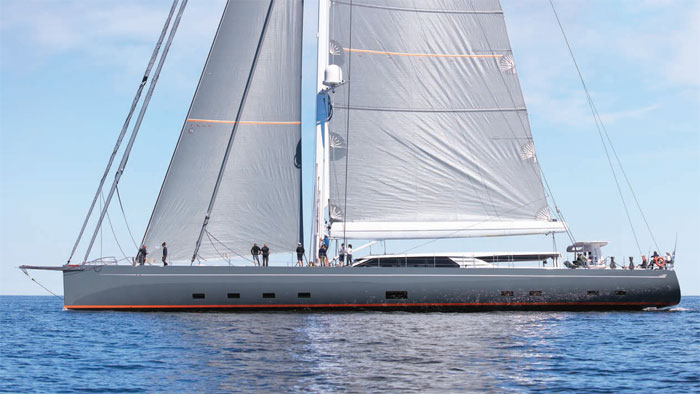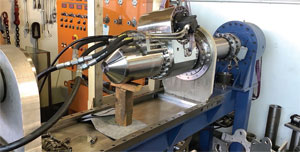

Every time Reckmann supplies a new superyacht sailing system they surprise us by going one step further. With the Judel/Vrolijk 146-footer Path and 196-foot Sarissa II from McKeon they are doing it again...
The demand for giant sloop rigs continues apace in the superyacht sector and the need for reliable, failsafe sail furling systems becomes ever more crucial. Reckmann remains the go-to supplier for headsail, code sail and mainsail reefing hardware, thanks to its rock-solid reputation and the steady stream of incremental refinements that stem from the Hamburg-based company’s long-term strategy of continuous R&D. Two of its latest projects – both high-performance superyachts, but with completely different design values and sailing programmes – demonstrate the versatility of the Reckmann product range.
Path is a remarkably spacious 146ft (44.5m) cutter-rigged sloop with a Panamax carbon rig and integrated sailing system from Rondal. Designed by Judel/Vrolijk specifically for fast-paced round-theworld voyaging and built in foam-cored carbon composites by Baltic Yachts, it’s the third-largest yacht by volume that Baltic has built to date. Delivered in July and due to be on display at this year’s Monaco Yacht Show, Path puts a very strong (and sensible) emphasis on reliability, autonomy and fully proven technologies. Genuine all-weather sailing capability and the ability to go off grid in remote cruising grounds for long periods of time were key aspects of the design brief.
Even larger at 196ft (59.7m) overall and much less conservative in concept, Sarissa II is a sleek and striking Malcolm McKeon design due for delivery in 2022. Described as a no-compromise performance sloop with exceptional sail power, it’s intended to be one of the most iconic superyachts afloat. Currently in build at Royal Huisman under a strict veil of secrecy and codenamed Project 404, it’s constructed in Alustar 5059 aluminium with a low-profile carbon fibre deckhouse, hi-tech operating systems and a towering Southern Spars rig with some new innovations in integrated rig control. Unusually for a sailing yacht, its key features include a large, wide-opening beach club astern and fold-down boarding platforms amidships on both sides. While primarily a cruiser, racing is definitely on the agenda.
One thing that these two very different yachts have in common is a full set of Reckmann headsail, staysail and code sail furlers, with lightweight carbon headfoils. Path’s Rondal Performance Furling Boom – one of the stand-out innovations in the highly regarded Rondal Integrated Sailing System – is also fitted with a Reckmann in-boom mainsail reefing gear.
For Path, durability, reliability and a minimal maintenance schedule were key selection criteria, so Reckmann was the obvious choice. ‘The most important maintenance is to keep the gears as clean as possible and to wash the salt water off,’ says Reckmann managing director Marcus Schuldt. ‘A standard maintenance procedure usually happens after around five years when the rig gets pulled for inspection. In most cases, the opportunity is taken to send the furler back to us for a proper factory service. During this type of service, the furler will be taken apart and checked. Bearings and seals will be replaced and we do a performance test on our testing rig before we send the furler back to the boat.’
The brief from Path’s owner called for relatively simple sailing systems but the rig design team still managed to achieve a notably smooth sequence of sail reductions. The sailplan follows Judel/Vrolijk’s well-proven ocean cruising configuration of blade jib and staysail on the bow, quite closely spaced but carefully optimised to ensure a smooth laminar flow when the outer sail is furled, and a permanently rigged inner working jib. All of these are carried on hydraulicpowered Reckmann under-deck furlers with maximum torque of 1628Nm at 175bar, 1160Nm at 140bar, and 800Nm at 150bar respectively. The two big headsails can each be unfurled in about 60 seconds and completely furled in 80 to 120 seconds. On both of these furlers, a huge 6,500Nm of braking moment ensures smooth operation and precise control even when fully loaded in heavy weather.
Forward of the headsails and permanently mounted on the stemhead, the powerful code zero is Path’s primary driver on most points of sail from a fetch to a broad reach. A removable bowsprit is bolted on and a big A3 is deployed occasionally for regattas, but on passage and in delivery mode the bowsprit is stowed and the code sail serves that purpose more than adequately instead. Reckmann’s CZ-32 has the power – 1080Nm of torque at 180bar and 1,200Nm of braking moment – to unfurl this beast of a sail in just 40 seconds and furl it away again in 60 to 80 seconds.
For an all-weather ocean cruising yacht, the ability to achieve a tight furl on all sails and hold it reliably in any conditions is of paramount importance. ‘A tight furl needs proper headstay tension and a sufficient torque performance of the gear, which we have, and to hold the sheet a little tighter while furling the sail,’ Schuldt says. ‘We achieve a static self braking mechanism by either a special worm gear design on the headsail units or a brake which is part of the hydraulic motor assembly.’ Another key feature of Reckmann furlers is their ability to avoid the dreaded stick-slip effect that can send violent shudders through the rig when less well-engineered furling gear operates under high loads. ‘ We use a special material which is used for propeller shafts and other marine applications as well where parts must rotate under all circumstances,’ Schuldt explains. ‘This expensive material avoids the slip stick effect perfectly.’ The design of Reckmann’s halyard swivel also helps: ‘We produce our own special bearings for our halyard swivels to achieve a compact, high load swivel with a reduced friction under load.’
The carbon headfoils supplied by Reckmann deliver significant performance benefits. ‘The weight advantage of the carbon S8 foil on the headstay compared to a comparable aluminium foil is 3kg per metre, which means 180kg on the entire forestay,’ Schuldt explains. ‘The difference of the S7 carbon foil on the inner forestay to an aluminium foil is 100kg in total on the stay. These much lighter carbon foils also allow a much better sail shape and performance. There is less tension needed to get the entire stay straight and tight.’
Sarissa II’s sailplan details and sailing programme are strictly confidential, like most other aspects of that project, but the equipment supplied by Reckmann suggests a versatile setup that is equally suited to fully crewed racing in superyacht regattas and long-range ocean passages with a shorthanded crew.
The dimensions and loads of Sarissa II’s huge headsail required a new, more powerful product with two hydraulic drives to be added to Reckmann’s UD series of under-deck headstay furlers. ‘The UD-7.5scRT is a new design and it will go on another, even bigger superyacht as well,’ Schuldt says. ‘On this yacht it will be equipped with the light and strong S9.5 carbon foils which we have supplied to some other wellknown superyachts. These foils allow you to reef the headsail and to sail partially reefed.’

Three Reckmann SF-series staysail furlers have also been supplied: an SF-65s for the working jib, an SF-45s storm jib furler and an SF-30s for the code sail. All of these have been customised with a special bead-blast finish and the code sail furler’s hydraulic stay adjuster has a custom stroke length.
‘We have a more or less standard design and do custom modifications if needed to match the client’s expectations and wishes,’ Schuldt says. ‘The SF is a combination of a turning padeye and a hydraulic stay tensioner. The self-aligning deck suspension allows a flush deck installation and avoids bending loads on the extended piston. The furler is equipped with a strong hydraulic brake and a removable stay connector with a quick release pin for fast sail changes.’
Reckmann furlers are already equipped with accurate and reliable built-in load sensors, and Schuldt expects them to interface with increasingly sophisticated and advanced load-sensing systems on next-generation superyachts like Sarissa II. ‘There are very few boats that already have a very good load measuring system installed,’ he says. ‘But nowadays it is even more important to know the loads in the mast and rig while sailing, if you don’t want to oversize the equipment. Such a control system should allow you to adjust the sailing gear as soon as the load limits are reached.’
Click here for more information on Reckmann »
We invite you to read on and find out for yourself why Seahorse is the most highly-rated source in the world for anyone who is serious about their racing.
To read on simply SIGN up NOW
Take advantage of our very best subscription offer or order a single copy of this issue of Seahorse.
Online at:
www.seahorse.co.uk/shop and use the code TECH20
Or for iPad simply download the Seahorse App at the iTunes store


